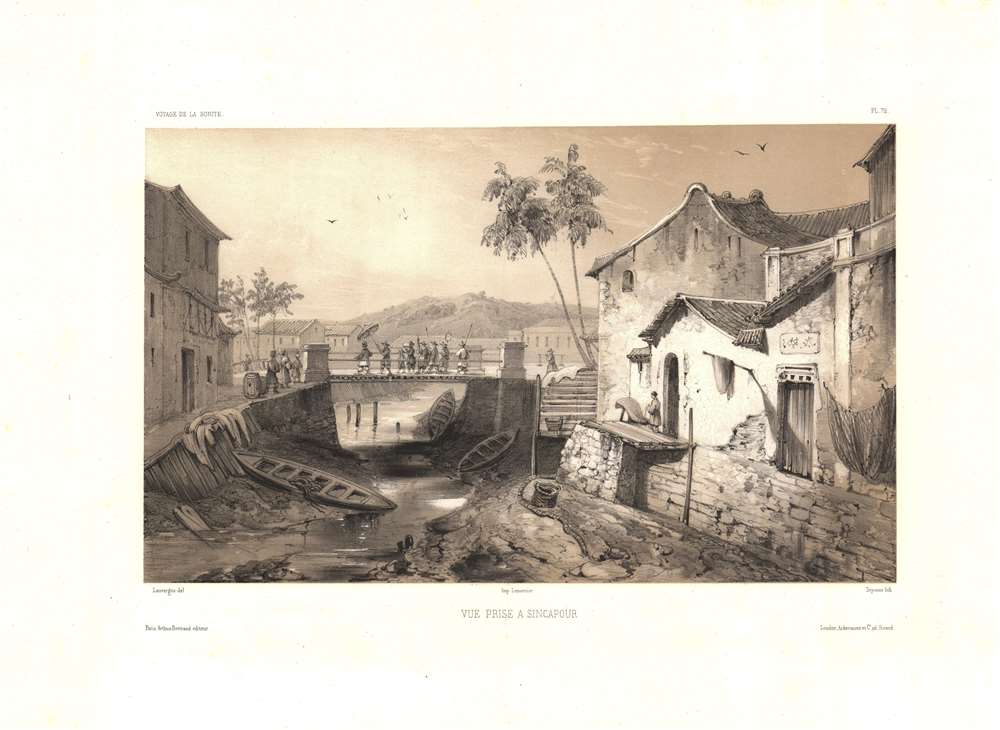1841 Lauvergne View of the Singapore River, Singapore
SingaporePrise-lauvergne-1841
Title
1841 (undated) 0 x 14 in (0 x 35.56 cm)
Description
Lauvergne was one of several artists accompanying the 1836 - 1837 Auguste-Nicolas Vaillant (1793 - 1858) circumnavigation. The scientific expedition arrived in Singapore on February 17, 1837 and stayed through February 23rd. It is safe to assume that Lauvergne sketched this view during the expedition's brief stay.
Chromolithography
Chromolithography is a color lithographic technique developed in the mid-19th century. The process involved using multiple lithographic stones, one for each color, to yield a rich composite effect. Oftentimes, the process would start with a black basecoat upon which subsequent colors were layered. Some chromolithographs used 30 or more separate lithographic stones to achieve the desired product. Chromolithograph color could also be effectively blended for even more dramatic results. The process became extremely popular in the late 19th and early 20th centuries, when it emerged as the dominate method of color printing. The vivid color chromolithography produced made it exceptionally effective for advertising and propaganda imagery.Publication History and Census
This view was originally drawn by Barthélemy Lauvergne in 1837. The view was not published until about 1840, when it was printed for the Album Historique, a collection of maps and views prepared to accompany Auguste Nicholas Vaillant's Voyage Autour du Monde exécuté pendant les années 1836 et 1837 sur la Corvette la Bonit. The Album Historique must have been issued in much smaller quantities than the Voyage Autour du Monde, as it is exceedingly rare, whereas the narrative is only somewhat rare. This view was engraved by Jean Louis Tirpenne. It was printed by Lemercier, Benard et Cie., Paris. The view was published jointly by Arthus Bertrand (1840 - 1866) in Paris and Ackermann in London.CartographerS
Barthélemy Lauvergne (July 4, 1805 - November 15, 1871) was a French painter, maritime, and landscape artist active throughout the middle years of the 19th century. Lauvergne was born in Tulon and mastered drawing under Pierre Letuaire (1798 - 1885). He was immediately drawn the exotic and began to travel son after reaching adulthood - circumnavigating the world three times. He first accompanied the French naval officer Jules Sébastien César Dumont d'Urville (1790 - 1842) onboard the L'Astrolabe (1826 - 1829), then Cyrille Pierre Théodore Laplace (1793 - 1875) on La Favorite (1830 - 1832), and finally Auguste-Nicolas Vaillant (1793 - 1858) La Bonite (1836 - 1837). He also participated as an artist on Arctic voyages to Iceland, Spitzbergen, Finland, and Norway. In February of 1841 he was appointed to the Dépôt des Cartes et Plans de la Marine, where with government sponsorship, he published hundreds of finely lithographed images from his voyages - creating unique visual record of cultural interactions between European explorers and indigenous peoples. He painted a portrait of Napoleon III in 1851. Lauvergne retired to his hometown, Toulon, in 1863, and died 8 years later in 1871. More by this mapmaker...
Rose-Joseph Lemercier (June 29, 1803 - 1887) was a French photographer, lithographer, and printer. One of the most important Parisian lithographers of the 19th century, Lemercier was born in Paris into a family of seventeen children. His father was a basket maker, and he even began working as a basket maker at the age of fifteen, but Lemercier was drawn to lithography and printing and soon entered into an apprenticeship with Langlumé, where he worked from 1822 until 1825. After working for a handful of other printers, Lemercier started his own firm in 1828 at 2, rue Pierre Sarrazin with only one printing press. He subsequently moved a few more times before arriving at 57, rue de Seine, where he founded the printing firm Lemercier and Company. He created the firm Lemercier, Bénard and Company in 1837 with Jean François Bénard. Lemercier bought out Bénard's share in the firm in 1843 and, since his two sons died at a young age, he decided to bring his nephew Alfred into the business beginning in 1862, who would progressively take on more and more responsibility in running the firm. Between 1850 and 1870, Lemercier's firm was the largest lithographic company in Paris. The firm began to decline in prestige in the early 1870s, and, after Lemercier's death in 1887, its descent only quickened. It is unclear when the firm closed, but Alfred directed the firm until his death in 1901. Learn More...
Jean Louis Tirpenne (August 26, 1801 - January 17, 1867) was a French-German painter, lithographer, and dramatist active in Paris in the mid-19th century. Tirpenne was born in Hamburg, Germany. He studied painting under Boutron. Tirpenne contributed to the lithographic work associated with the Auguste-Nicolas Vaillant (1793 - 1858) circumnavigation, particularly with regard to the work's views of Singapore. He died in Paris in 1867. Learn More...
Ackermann (1795 - 199x) was a British publishing firm founded by Rudolph Ackermann (April 20, 1764 - March 30, 1834). First known as R. Ackermann and Company, Ackermann's three sons took over the business when their father retired. The firm was known as A. Ackermann and Son in the early 20th century and had offices in London, Paris, New York, and Chicago. Their New York office was exceptionally prolific, issuing work for both the private and government sectors. Ackermann was acquired in late 1990s and the imprint resurrected. Learn More...

